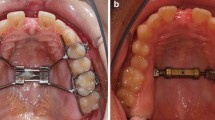Abstract.
Background:
Rapid maxillary expansion (RME) with the appliance fixed at the crowns of the first premolars and molars leads not only to transversal expansion but also to tipping of the anchorage teeth and a risk of increased tooth mobility as well as of root and bone resorptions. These disadvantages were to be avoided by fixing the transversal screw directly to the hard palate.
Material and Method:
Following preliminary experimental work to determine the extent to which the hard palate could be loaded with orthodontic implants, two female patients were treated for extreme transverse maxillary deficiency using a Hyrax expansion screw fixed on one side with an implant with the following dimensions: length 4.0 mm, diameter 3.5 mm, abutment diameter 5.00 mm (EO implant, Straumann, Freiburg i. Br., Germany), and on the other side with a bone screw between the roots of the second premolars and the first molars. Presurgical osteotomy according to Glassmann was followed immediately by loading, i. e. by expansion through activation of the screw several times per day. Additional anterior guidance of the right and left maxilla was provided by crossed segmented archwires and a tension coil spring for space opening in the incisor region. After adequate expansion by 8.0 mm and correction of the position of the buccal teeth, the Hyrax expansion screw and the osteosynthesis screw were removed. The implant served as orthodontic anchorage for a molar-to-molar transpalatal bar aimed at preventing relapse.
Results and Conclusions:
The tooth axis inclination measured on cut sections of the plaster casts made at the beginning and end of treatment was largely without transversal discrepancies. Direct fixing of the transversal screw in the palatal arch prevents buccal tipping of the posterior teeth, especially in patients with a small apical base. Compared with other direct procedures involving osteosynthesis plates, this technique offers adequate guiding stability and is minimally invasive.
Zusammenfassung.
Hintergrund:
Die forcierte Gaumennahterweiterung mit Fixierung der Apparatur an den Kronen der ersten Prämolaren und Molaren führt neben der transversalen Expansion zur Kippung der Verankerungszähne. Außerdem besteht das Risiko der Zahnlockerung, der Wurzel- und Knochenresorption. Mit der direkten Fixierung der Transversalschraube am knöchernen Gaumen sollen diese Nachteile vermieden werden.
Material und Methode:
Nach experimenteller Vorarbeit hinsichtlich der Belastungsfähigkeit des knöchernen Gaumens durch orthodontische Implantate wurde bei zwei Patientinnen zur Korrektur eines extremen Schmalkiefers die Hyraxschraube einerseits mit einem Implantat mit 4,0 mm Länge, 3,5 mm Durchmesser und Auflage (5,0 mm) (EO-Implantat, Straumann, Freiburg i. Br., Deutschland) und andererseits mit einer Knochenschraube zwischen den Wurzeln der zweiten Prämolaren und ersten Molaren befestigt. Nach kortikaler Knochenschwächung (Methode nach Glassmann) erfolgte eine sofortige Belastung bzw. Dehnung durch mehrmalige Aktivierung der Schraube pro Tag. Mittels überkreuzter Teilbögen und einer Zugfeder zur Lückenöffnung im Schneidezahnbereich erfolgte eine zusätzliche anteriore Führung der beiden Kiefersegmente. Nach ausreichender Weitung von 8,0 mm und Überstellung der Seitenzähne wurden die Hyraxschraube und die Knochenschraube entfernt. Das Implantat diente als orthodontische Verankerung für einen Transpalatinalbogen, der von den Molaren ausging und zur Retention der erzielten Weitung diente.
Ergebnisse und Schlussfolgerungen:
Die an Sägeschnitten der Anfangs- und Endmodelle gemessene Zahnachsenneigung blieb weitestgehend parallel. Mit der direkten Fixierung der Transversalschraube im Gaumenbogen kann vor allem bei kleiner apikaler Basis eine Bukkalkippung der Seitenzähne vermieden werden. Gegenüber anderen direkten Verfahren, mit breiter Anlagerung der Osteosyntheseplatten, ist das Verfahren bei ausreichender Führungsstabilität minimal invasiv.
Similar content being viewed by others
Author information
Authors and Affiliations
Corresponding author
Rights and permissions
About this article
Cite this article
Harzer, W., Schneider, M. & Gedrange, T. Rapid Maxillary Expansion with Palatal Anchorage of the Hyrax Expansion Screw—Pilot Study with Case Presentation. J Orofac Orthop 65, 419–424 (2004). https://doi.org/10.1007/s00056-004-0346-7
Received:
Accepted:
Issue Date:
DOI: https://doi.org/10.1007/s00056-004-0346-7




